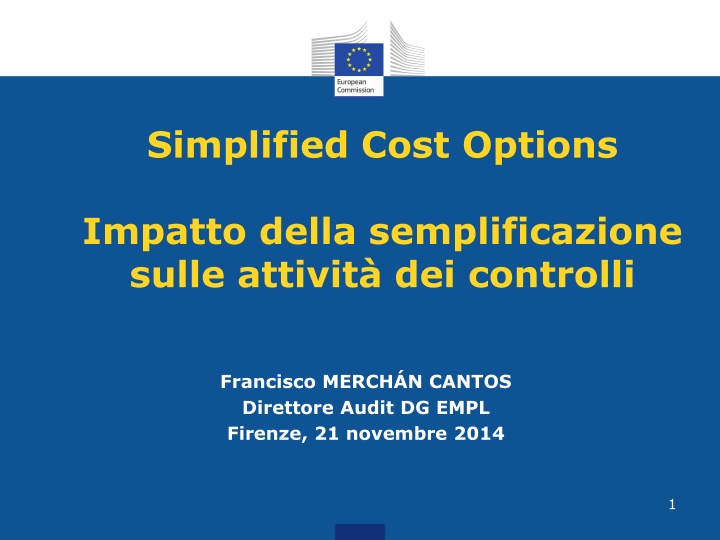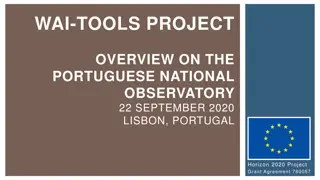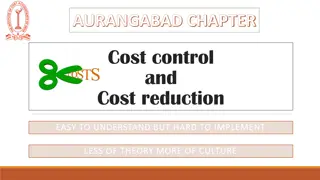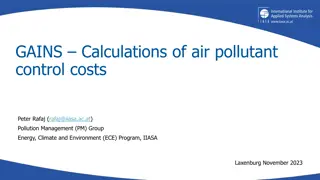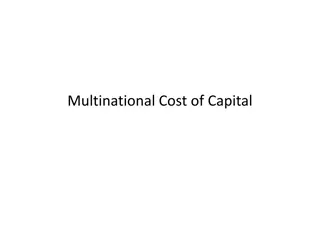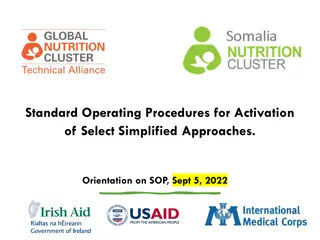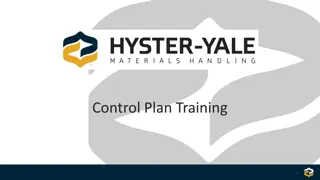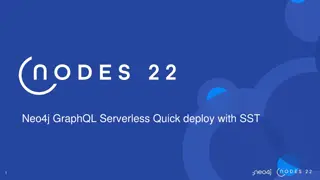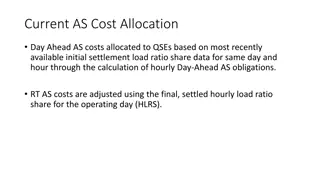Impact of Simplified Cost Options on Control Activities
The document discusses the benefits of using Simplified Cost Options (SCOs) in managing control activities, citing examples from the European Court of Auditors. It highlights reduced error rates and administrative burdens, recommending extensive use of SCOs for improved efficiency and effectiveness in operations.
Download Presentation

Please find below an Image/Link to download the presentation.
The content on the website is provided AS IS for your information and personal use only. It may not be sold, licensed, or shared on other websites without obtaining consent from the author.If you encounter any issues during the download, it is possible that the publisher has removed the file from their server.
You are allowed to download the files provided on this website for personal or commercial use, subject to the condition that they are used lawfully. All files are the property of their respective owners.
The content on the website is provided AS IS for your information and personal use only. It may not be sold, licensed, or shared on other websites without obtaining consent from the author.
E N D
Presentation Transcript
Simplified Cost Options Impatto della semplificazione sulle attivit dei controlli Francisco MERCH N CANTOS Direttore Audit DG EMPL Firenze, 21 novembre 2014 1
Table of content 1. Simplified Cost Options CPR 2. Audit of Simplified Cost Options 3. Joint Action Plan (JAP) 4. Art. 14.1 Reg (EU) 1304/2013 2
Why should MSs use SCOs? Outputs and results Error rate Administrative burden 3
European Court of Auditors 2012 DAS 57% (12/21) of the ESF OPs sampled by ECA used SCOs 24% (43/175) of the sampled ESF transactions used SCOs (24 standard costs, 15 flat rates, 4 lump sums) 2013 DAS 58% (14/24) OPs sampled used SCOs 18% (31/175) of the sampled ESF transactions used SCOs DAS 2012/2013 results: no errors linked to the utilisation of SCOs ECA recommends the extensive use of SCOs
Flat rate financing Simplified Cost Options CPR Art 67-68 Standard scales of unit costs Lump sums 5
Significantly extended options Ex ante evaluation Fair, Equitable and Verifiable method Use of existing EU schemes (for similar type of operation and beneficiary) Use of existing own national schemes (for similar type of operation and beneficiary) Use of specific rates and methods from the CPR and Fund specific regulations On the basis of a draft budget (ESF, <100.000 EUR of public support) 6
Statistical data or other objective information The verified historical data of individual beneficiaries The application of the usual cost accounting practices of individual beneficiaries 7
Enhanced legal certainty: Article 68(1) (b) CPR: flat rate of up to 15% of eligible direct staff costs for indirect costs Article 68(2) CPR: the hourly rate can be calculated by dividing the latest documented annual gross employment costs by 1 720 hours Article 14(2) ESF: a flat rate of up to 40% of the eligible direct staff costs to cover the remaining eligible costs Article 19 ETC: the direct staff costs can be calculated at a flat rate of up to 20% of the direct costs other than the staff costs. 8
Compatible with EU and national rules on eligibility Compatible with State Aid rules Not 100% public procurement Grant or refundable assistance SCO applicable if 9
Table of content 1. Simplified Cost Options 2. Audit of Simplified Cost Options 3. Joint Action Plan (JAP) 4. Art. 14.1 Reg (EU) 1304/2013 10
General audit approach Ensure that the audit approach is aligned with simplification objectives Expenditure calculated according to: Outputs/results, if unit costs/lump sums applied Direct costs, if flat rate for indirect costs applied Resulting amount is considered as expenditure incurred by the beneficiary No audit of actual costs and supporting financial documents for each operation Audit of methodology vs audit of specific operations
Audit of SCOs What is being checked, and where? Check of the methodology Verification of the supporting documents (also at beneficiary level) Managing Authority Check of the application of the methodology No verification of the underlying actual costs Beneficiary 12
Audit trail Methodology: MA/IB to maintain full records on the methodology and the basis for setting the standard scales, lump sums or flat rates (if calculated) Operations: beneficiary to maintain an adequate audit trail and supporting documents: Outputs/results: if lump sums or standard scales of unit costs applied Direct costs: if flat rate for indirect costs applied Article 140 of Reg. (EC) No 1303/2013 on availability of documents applies (2-3 years after 31 December following submission of accounts)
Operations Correct implementation of methodology Verification of supporting evidence/documents for outputs (lump sums, standard scales of unit costs) or direct costs (flat rate for indirect costs) No audit of actual costs or underlying financial documents Verification of compliance with all applicable Community and national rules on eligibility, public procurement, etc.
Compliance Public procurement If beneficiary outsources entire implementation via public procurement, SCOs cannot be applied If insourced, SCOs can be applied even if some categories of costs are procured If applicable, verify compliance with public procurement rules State Aid regulation De minimis, GBER Maximum aid intensity; notification thresholds Publicity requirements 15
Good practices Clear and direct link with operation Easy to justify quantities, activities, outputs, outcomes Ensure economic balance of operation and beneficiary (e.g.: several levels of payments for lump sums) Mitigate risk of "creaming" participants Clear definition of categories of expenditure; avoid overlaps Consider adaptation in methodology (inflation, salaries, etc) 16
Table of content 1. Simplified Cost Options 2. Audit of Simplified Cost Options 3. Joint Action Plan (JAP) 4. Art. 14.1 Reg (EU) 1304/2013 17
What is a Joint Action Plan (JAP)? An operation focused on results: defined and managed in relation to what should be achieved A JAP involves setting an objective and implementing projects which will produce the outputs and results necessary to achieve objective Payments take the form of unit costs and/or lump sums, linked to outputs and results of each project => shift in the focus of management => entire operation will be implemented via a set of unit costs/lump sums related to projects 18
How can a JAP be set up? A JAP beneficiary (public law body) prepares the JAP proposal The intervention logic SCOs defined for each project JAP is submitted to Commission for approval Commission Decision approving a JAP contains the costs for each SCOs to be used JAP is implemented and reimbursed on the basis of the progress achieved through agreed unit costs and lump sums 19
How does it all fit together? JAP = 1 Operation = Part of OP(s) Project 3 O P Milestones Outputs Results Output B E N E F I C I A I R Y A U T H O R I T I E S Project 4 Output & Results E C Project 1 Output & Results Payments Payments Output & Results Project 2 20 Commission Decision
Basic requirements Can combine resources from one or more programmes Financing from ESF, ERDF, and or Cohesion fund => multifund JAPs are possible, but no infrastructure Beneficiary = public law body, can work with partners JAP thresholds 10 MEUR/20% of OP 5 MEUR per programme for a pilot JAP No threshold for a YEI JAP No specific requirement on duration, but shorter than OP Legal basis: Art. 104-109 CPR + JAP model 21
Making use of SCOs Payments take the form of unit costs and/or lump sums (no flat rates), defined for indicators depend on level of achievement! Up to 10% flexibility within allocation to outputs / allocation to results Costs for SCOs based on art.67(5) CPR and art. 14 ESF No capping for lump sums (can exceed 100,000 EUR) Regardless of how projects are implemented, beneficiary is reimbursed on the basis of agreed UC/LS also applicable to fully procured projects 22
Table of content 1. Simplified Cost Options 2. Audit of Simplified Cost Options 3. Joint Action Plan (JAP) 4. Art. 14.1 Reg (EU) 1304/2013 23
Article 14.1 Reg (EU) 1304/2013 Introduces the possibility for the EC to reimburse funds to MS on the basis of standard scales of unit cost and lump sums, independently of the financial arrangements between the MS and the beneficiary. The Delegated Act will allow the MA to transform outputs and results of operations into amounts included in the statement of expenditure. The amount declared to the EC is based on the agreed cost of each unit delivered (a result achieved does not necessarily correspond to expenditure incurred by the beneficiary or to payments made by MA). 24
Article 14.1 Reg (EU) 1304/2013 The EC proposes the MS to submit their own data with an optional assessment of the AA. The Delegated Act should be in force until the end of the programming period. Before its entry into force, MS can use the unit cost under its own responsibility but under the legal framework of art. 67 1303/2013. The Delegated Act should cover a set of unit costs and lump sums applicable to the OPs or parts of the OP. The limit of lump sum of art. 67 CPR does not apply to art. 14.1. These unit costs and lump sums should be usable for operations representing significant amounts of the OP, cover all or most of the costs related to an operation and be based on a fair, equitable and verifiable calculation method. 25
Article 14.1 Reg (EU) 1304/2013 Financial management, audit and control of operations reimbursed by the EC is exclusively based on the outputs and results attached to the standard scales of unit costs and lump sums. It is possible to support operations that are exclusively procured. The MS system to collect and store output and result data have to be robust and reliable (any weakness could lead to financial corrections). A reliable monitoring system of the beneficiary is also absolutely essential. The beneficiary may apply its own accounting practices even if this results in different amounts than those calculated with the lump sums and unit costs used. 26
Thank you for your attention! Francisco Merch n Audit Director DG Employment, Social Affairs and Inclusion 27
